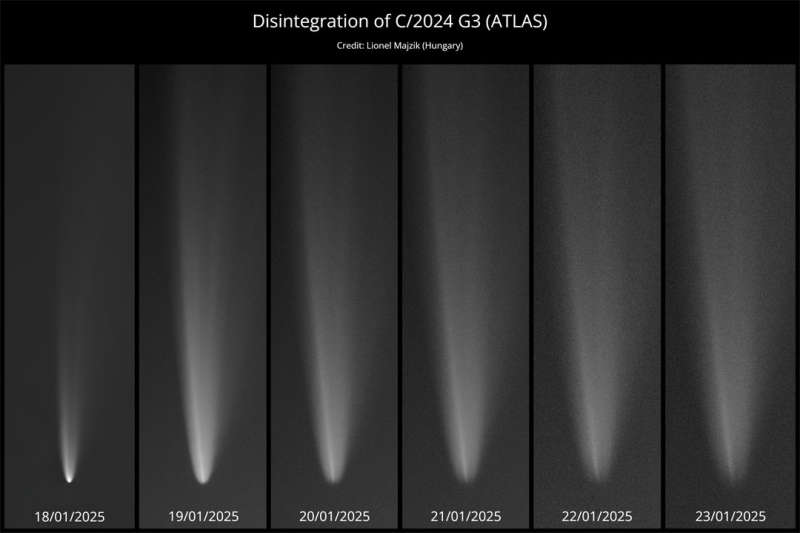
|
Credit & Copyright: Lionel Majzik
Explanation:
What's happening to Comet G3 ATLAS?
After
passing near the Sun in mid-January,
the head of the comet has become dimmer and dimmer.
By late January, Comet
C/2024 G3 (ATLAS)
had become a
headless wonder -- even though it continued to show
impressive
tails after sunset in the skies of
Earth's
Southern Hemisphere.
Pictured are images of Comet G3 ATLAS on successive January nights taken from
Röo Hurtado,
Chile.
Clearly, the comet's head is brighter and more
centrally condensed on the earlier days (left) than on later days (right).
A key reason is likely that the
comet's nucleus of ice and rock, at the
head's center, has
fragmented.
Comet G3 ATLAS passed
well inside the orbit of
planet Mercury
when at its solar closest, a distance that where heat
destroys
many
comets.
Some of comet G3 ATLAS' scattering remains
will continue to orbit the Sun.
Gallery:
Comet
G3 ATLAS
|
January February March April May June July August September October November December |
| ||||||||||||||||||||||||||||||||||||||||||||||||
NASA Web Site Statements, Warnings, and Disclaimers
NASA Official: Jay Norris. Specific rights apply.
A service of: LHEA at NASA / GSFC
& Michigan Tech. U.
Based on Astronomy Picture
Of the Day
Publications with keywords: comet
Publications with words: comet
See also:
- APOD: 2025 December 1 Á 3I ATLAS: Tails of an Interstellar Comet
- APOD: 2025 November 25 Á Comet Lemmon and the Milky Way
- 3I/ATLAS: A View from Planet Earth
- APOD: 2025 November 17 Á Comet Lemmons Wandering Tail
- APOD: 2025 September 30 Á Comet Lemmon Brightens
- APOD: 2025 September 29 Á Two Camera Comets in One Sky
- APOD: 2025 September 26 Á A SWAN an ATLAS and Mars
